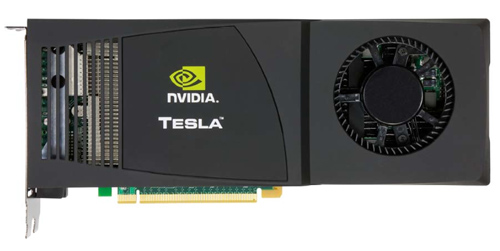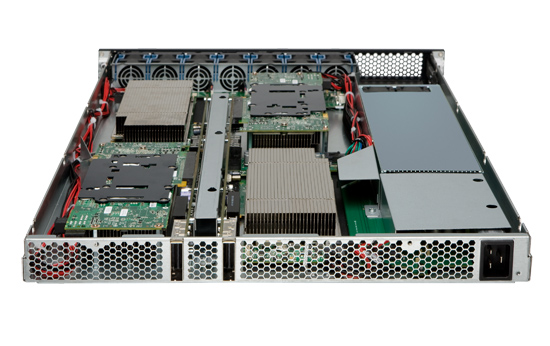NVIDIA's Fermi: Architected for Tesla, 3 Billion Transistors in 2010
by Anand Lal Shimpi on September 30, 2009 12:00 AM EST- Posted in
- GPUs
A Different Sort of Launch
Fermi will support DirectX 11 and NVIDIA believes it'll be faster than the Radeon HD 5870 in 3D games. With 3 billion transistors, it had better be. But that's the extent of what NVIDIA is willing to talk about with regards to Fermi as a gaming GPU. Sorry folks, today's launch is targeted entirely at Tesla.

A GeForce GTX 280 with 4GB of memory is the foundation for the Tesla C1060 cards
Tesla is NVIDIA's High Performance Computing (HPC) business. NVIDIA takes its consumer GPUs, equips them with a ton of memory, and sells them in personal or datacenter supercomputers called Tesla supercomputers or computing clusters. If you have an application that can run well on a GPU, the upside is tremendous.

Four of those C1060 cards in a 1U chassis make the Tesla S1070. PCIe connects the S1070 to the host server.
NVIDIA loves to cite examples of where algorithms ported to GPUs work so much better than CPUs. One such example is a seismic processing application that HESS found ran very well on NVIDIA GPUs. It migrated a cluster of 2000 servers to 32 Tesla S1070s, bringing total costs down from $8M to $400K, and total power from 1200kW down to 45kW.
| HESS Seismic Processing Example | Tesla | CPU |
| Performance | 1 | 1 |
| # of Machines | 32 Tesla S1070s | 2000 x86 servers |
| Total Cost | ~$400K | ~$8M |
| Total Power | 45kW | 1200kW |
Obviously this doesn't include the servers needed to drive the Teslas, but presumably that's not a significant cost. Either way the potential is there, it's just a matter of how many similar applications exist in the world.
According to NVIDIA, there are many more cases like this in the market. The table below shows what NVIDIA believes is the total available market in the next 18 months for these various HPC segments:
| Processor | Seismic | Supercomputing | Universities | Defence | Finance |
| GPU TAM | $300M | $200M | $150M | $250M | $230M |
These figures were calculated by looking at the algorithms used in each segment, the number of Hess-like Tesla installations that can be done, and the current budget for non-GPU based computing in those markets. If NVIDIA met its goals here, the Tesla business could be bigger than the GeForce one. There's just one problem:
As you'll soon see, many of the architectural features of Fermi are targeted specifically for Tesla markets. The same could be said about GT200, albeit to a lesser degree. Yet Tesla accounted for less than 1.3% of NVIDIA's total revenue last quarter.
Given these numbers it looks like NVIDIA is building GPUs for a world that doesn't exist. NVIDIA doesn't agree.
The Evolution of GPU Computing
When matched with the right algorithms and programming efforts, GPU computing can provide some real speedups. Much of Fermi's architecture is designed to improve performance in these HPC and other GPU compute applications.
Ever since G80, NVIDIA has been on this path to bring GPU computing to reality. I rarely get the opportunity to get a non-marketing answer out of NVIDIA, but in talking to Jonah Alben (VP of GPU Engineering) I had an unusually frank discussion.
From the outside, G80 looks to be a GPU architected for compute. Internally, NVIDIA viewed it as an opportunistic way to enable more general purpose computing on its GPUs. The transition to a unified shader architecture gave NVIDIA the chance to, relatively easily, turn G80 into more than just a GPU. NVIDIA viewed GPU computing as a future strength for the company, so G80 led a dual life. Awesome graphics chip by day, the foundation for CUDA by night.
Remember that G80 was hashed out back in 2002 - 2003. NVIDIA had some ideas of where it wanted to take GPU computing, but it wasn't until G80 hit that customers started providing feedback that ultimately shaped the way GT200 and Fermi turned out.
One key example was support for double precision floating point. The feature wasn't added until GT200 and even then, it was only added based on computing customer feedback from G80. Fermi kicks double precision performance up another notch as it now executes FP64 ops at half of its FP32 rate (more on this later).
While G80 and GT200 were still primarily graphics chips, NVIDIA views Fermi as a processor that makes compute just as serious as graphics. NVIDIA believes it's on a different course, at least for the short term, than AMD. And you'll see this in many of the architectural features of Fermi.










415 Comments
View All Comments
Griswold - Wednesday, September 30, 2009 - link
Well, you have to consider that nvidia is getting between a rock and a hard place. The PC gaming market is shrinking. Theres not much point in making desktop chipsets anymore... they have to shift focus (and I'm sure they will focus) on new things like GPGPU. I wont be surprised if GT300 wont be a the super awesome gamer GPU of choice so many people expect it to be. And perhaps, the one after GT300 will be even less impressive for gaming, regardless of what they just said about making humongous chips for the high-end segment.SiliconDoc - Wednesday, September 30, 2009 - link
Gee nvidia is between a rock and a hard place, since they have an OUT, and ATI DOES NOT.lol
That was a GREAT JOB focusing on the wrong player who is between a rock and a hard place, and that player would be RED ROOSTER ATI !
--
no chipsets
no chance at TESLA sales in the billions to coleges and government and schools and research centers all ove the world....
--
buh bye ATI ! < what you should have actually "speculated"
...
But then, we know who you are and what you're about -
TELLING THE EXACT OPPSITE OF THE TRUTH, ALL FOR YOUR RED GOD, ATI !
--
silverblue - Thursday, October 1, 2009 - link
When nVidia actually sends out Fermi samples for previews/reviews, only then will you know how good it is. We all want to see it because we want competition and lower prices (and maybe some of us will buy one or more, as well!).Until then, keep your fanboy comments to yourself.
SiliconDoc - Thursday, October 1, 2009 - link
No silverblue, that is in fact your problem, not mine, as you won't know anything, till you're shown a lie or otherwise, and it's shoved into your tiny processor for your personal acceptance.The fact remains, red fanboy raver Griswold blew it, and I pointed out exactly WHY.
The fact that you cry about it, because you group stupid dummies keep blowing nearly every statement you make, sure isn't my fault.
silverblue - Thursday, October 1, 2009 - link
I wonder if you do actually read posts before you reply to them.SiliconDoc - Thursday, October 1, 2009 - link
Take your own advice, you pathetic hypocrit.ClownPuncher - Thursday, October 1, 2009 - link
Its actually "hypocrite".SiliconDoc - Friday, October 2, 2009 - link
It's "it's", you pathetic hypocrit.silverblue - Friday, October 2, 2009 - link
It's "hypocrite", you pathetic hypocrite.chizow - Wednesday, September 30, 2009 - link
Nvidia is simply hedging their bets and expanding their horizons. They've still managed to offer the fastest GPUs per product cycle/generation and they're clearly far more advanced than AMD when it comes to GPGPU in both theory and practice.Jensen's keynote tipped his hat numerous times to Nvidia's roots as a GPU company that designed chips to run 3D video games, but the focus of his presentation was clearly to sell it as more than that, as a cGPU capable of incredible computational ability.